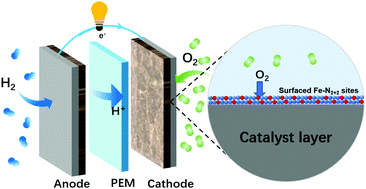Seizing gaseous Fe2+ to densify O2-accessible Fe–N4 sites for high-performance proton exchange membrane fuel cells†
Abstract
Increasing the density of Fe–N4 sites in Fe–N–C materials is pivotal for enhancing the kinetics of the oxygen reduction reaction (ORR) in proton exchange membrane fuel cells (PEMFCs). Fe utilization is a vital parameter for the Fe–N–C catalyst evaluation, but it shows a tendency to decrease with increasing density of the Fe–N4 sites. Herein, dense edge Fe–N2+2 sites are deposited in the outermost and subsurface layers of a surface-rich pyridinic-N carbon substrate (Feg–NC/Phen). We have demonstrated that the surface-rich pyridinic-N carbon substrate is more favorable to form surface Fe–N2+2 sites with superior intrinsic activity. The surface Fe–N4 sites can improve both the site density and Fe utilization, while shortening the transport pathways of protons and O2 effectively. By means of these structural advantages, Feg–NC/Phen can exhibit a high current density of 0.046 A cm−2@0.9 ViR-free and a high peak power density (Pmax) of 1.53 W cm−2 in 2 bar H2–O2 PEMFCs, and outperform almost all the reported M–N–C catalysts. This outstanding performance will inspire relevant research in the distribution of active sites. Moreover, it requires particular attention to obtain a viable solution to performance durability in fuel cells.



 Please wait while we load your content...
Please wait while we load your content...